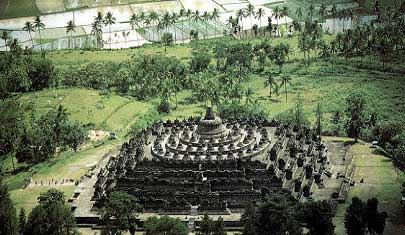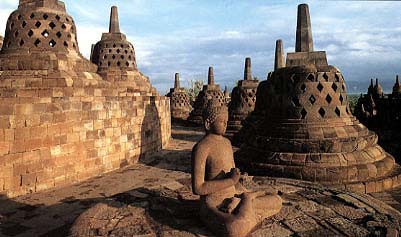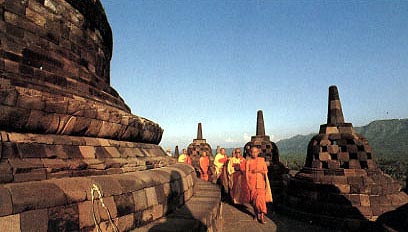
The Borobudur Temple is considered as one of the seven wonders of the world. This temple is located at Borobudur District, South of Magelang, Central Java.
The expression of experts who had been studying Borobudur Temple varied someway. Bernet Kempers' expression was: “Borobudur is Borobudur”, meaning that Borobudur Temple is very unique in her own way. Nieuwenkamp (an artist) imaginated Borobudur as “a big lotus flower bud ready to bloom” which was “floating” on a lake. Nieuwenkamp’s imagination was supported by N. Rangkuti (1987) that from the air, the Borobudur Temple looks floating. From the geological studies, experts were able to prove that Borobudur area was one time a big lake. Most of the villages around Borobudur Temple were at the same altitude, 235 meters above the sea-level. The same altitude included the Pawon and Mendut temples. Thus the area under 235 meter altitude was below the lake water level.
Based on the inscription dated 842 AD, Casparis suggested that Borobudur was one time a place for praying. The inscription stated a phrase such as: “Kawulan i Bhumi Sambhara”. Kawulan means the origin of holiness, “bhumi sambhara” is a name of a place in Borobudur. Paul Mus stated that Borobudur Temple had the structure of stupa (conical form) with double expression. As a whole, the Borobudur Temple was an open-flat stupa, but on the other hand, the temple expressed the idea of a “closed world”. The latter expression could be felt when one is already inside the temple. Whenever person is inside the temple, his or her view will be limited to high walls full on relieves, the verandah is always squared in such a way that one could not see other parts of the temple, even in a same floor. The same feeling happened if one stood on arupadhatu round platform, he or she will have a wider view only on that level, but are not able to see the lower level nor the upper level like the one on rupadhatu and kamandhatu. It could be said that Borobudur is a symbol of cosmic mountain covered by the sky roof, a specific world that could be reached through isolated alleys as stages. The closed structural design of the temple expressed the concept of a closed world, not just a technical reasons as had been suggested by other experts ( Daud AT, 1987)
Borobudur was built by Sanmaratungga in the 8th century, and belongs to Buddha Mahayana. Borobudur was revealed by Sir Thomas Stanford Raffles in 1814. The temple was found in ruined condition and was buried.
The overall height was 42 meters, but was only 34.5 meters after restoration, and had the dimension of 123 x 123 meters (15,129 square meters). There were 10 floors. The first floor up to the sixth floor was square form, the seventh to the tenth floor were round form.
Borobudur is facing to the East with a total of 1460 panels (2 meters wide each). Total size of the temple walls was 2500 square meters, full of relief. The total number of panels with relief was 1212. According to investigations, the total number of Buddha statue was 504 including the intact and damaged statues. The temple undergone restoration from 1905 to 1910, and the last restoration was done in 1973 to 1983.
1. Structural Design of Borobudur Temple
Ever since the first excavation, most experts speculated on the exact shape of the temple. Hoenig, in his book “Das form problem des Borobudur” speculate that the original form of Borobudur Temple had four gates and nine floors. The form of Borobudur Temple is similar to temples found in Cambodia. According to Parmenteir, the huge single stupa on top of the temple made the smaller stupas in the lower part looked drowned. Stutterheim who had been studying stupas in India and other parts of Asia concluded that the stupa structure was an Indian origin. The original purpose of stupa building was as storage of Buddha Gautama and other holy priests cremation ash.
According to Stutterheim, the overall form of Borobudur Temple is a combination of zigurat (middle Asian Pyramid) and Indian stupa. Stutterheim opinion was supported by the existence of this type of form in Ancient Javanese literature.
The relief of Borobudur temple started from the base of the temple up to the fourth platform. The relieves at the base contained the story of Karmawibhangga. Under the main panel and above the Karmawibhangga relief, a wide-sized relief was inscripted at the wall. From this point along the alley, the relief did not show story in the sequence, but as a repeating part of the story with the same motives which expressed the world of spiritual beings such as half demonic body (Gandharwa, giants or Yataka, dragon, Sidha or angels and their ladies friends, Apsara and Nagi, all of them are heavenly beings who are tender and beautiful.
Division of panels are: the first panel expressed a heavenly being in sitting position, on both side of this panel are small panel with a small standing statue. This figures are repeated 26 times for each side of the wall. Between the panels is carved three bodies, a male flanked by two women.
2. Relieves at the Walls of the Alley.
There was a long series of main relieves at the first alley, either at the main wall or at the inner side of Kutamara wall. Relieves at the Kutamara wall depicted Jataka's and Awadana's, a story of Buddha's life which expressed as Bodhisatwa, due to his good deeds in the past. Sometimes, Buddha is expressed in the form of animals such as rabbit, monkeys etc. As it was told in animated stories, the story was adopted from Sanskrit book, Jatakamala. Only one third of the relieves were known, the rest was still unclear.
The lower relieves of the main wall contained the same story. The upper relieves also had the same story as the lower one. The story contained the life of Buddha consisting of 120 frames until he began teaching Buddha religion. The first frame began from the South of stairway of the curved gate at the East, and follow the path of the sun (the temple on the right side). The life story of Buddha was adopted from Lalitawistara book.
At the second alley, Jataka and Awadana story were continued on the inner side of Utamara, and on the main wall, story was began with stories adopted from Gandhawyuha. This story was so long that it occupied the main wall and inner side wall of Utamara at the third and fourth alley. The story showed the adventure of a Sudhana who met Bodhisatwa Maytreya (the future Buddha) to have religious lesson from the Buddha. Later on, the Sudhana met with Bodhisatwa Mandjusri, and finally he met with Dyani Bodhisatwa Samanta Badra, who gave the highest wisdom. Most of those stories expressed the use of spiritual strength and unusual happenings.
There were many beautiful ornaments inscripted at the wall of the fourth alley, because the fifth alley did not contained any ornaments. The fifth alley is a transitional alley to the next platform, the round platform. The next round platforms also did not contained any ornaments at all (Kaylan,1959).
t temples. Thus the area under 235 meter altitude was below the lake water level.
Based on the inscription dated 842 AD, Casparis suggested that Borobudur was one time a place for praying. The inscription stated a phrase such as: “Kawulan iBhumi Sambhara”. Kawulan means the origin of holiness, “bhumi sambhara” is a name of a place in Borobudur. Paul Mus stated that Borobudur Temple had the structure of stupa (conical form) with double expression. As a whole, the Borobudur Temple was an open-flat stupa, but on the other hand, the temple expressed the idea of a “closed world”. The latter expression could be felt when one is already inside the temple. Whenever person is inside the temple, his or her view will be limited to high walls full on relieves, the verandah is always squared in such a way that one could not see other parts of the temple, even in a same floor. The same feeling happened if one stood on arupadhatu round platform, he or she will have a wider view only on that level, but are not able to see the lower level nor the upper level like the one on rupadhatu and kamandhatu. It could be said that Borobudur is a symbol of cosmic mountain covered by the sky roof, a specific world that could be reached through isolated alleys as stages. The closed structural design of the temple expressed the concept of a closed world, not just a technical reasons as had been suggested by other experts ( Daud AT, 1987)
Borobudur was built by Sanmaratungga in the 8th century, and belongs to Buddha Mahayana. Borobudur was revealed by Sir Thomas Stanford Raffles in 1814. The temple was found in ruined condition and was buried.
The overall height was 42 meters, but was only 34.5 meters after restoration, and had the dimension of 123 x 123 meters (15,129 square meters). There were 10 floors. The first floor up to the sixth floor was square form, the seventh to the tenth floor were round form.
Borobudur is facing to the East with a total of 1460 panels (2 meters wide each). Total size of the temple walls was 2500 square meters, full of relief. The total number of panels with relief was 1212. According to investigations, the total number of Buddha statue was 504 including the intact and damaged statues. The temple undergone restoration from 1905 to 1910, and the last restoration was done in 1973 to 1983.
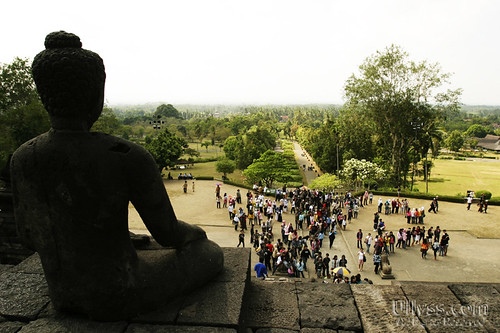
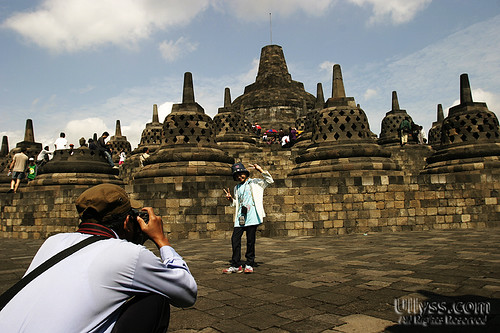



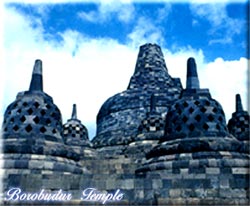
 One of the most beautiful WHS. So grand and full of lovely details in its wall.
One of the most beautiful WHS. So grand and full of lovely details in its wall. The Temple of Borobudur
The Temple of Borobudur






 The 300 year old city of Jogyakarta is the cultural heart of Java. Here also is Indonesia's oldest palace 'The Kraton,' still the domicile of Jogya's royalty. Even now the current Sultan of Jogyakarta retains remarkable political prestige. Jogyakarta offers an abundance of Javanese art, painting, silverwork, batik handcraft, traditional Javanese dances, as well as contemporary art. The city is the cultural centre not only of Java, but of the whole of Indonesia. From Jogyakarta one can travel easily to the Borobudur and Prambanan temples, which are half-day trips from the city. Jogyakarta is situated between the foot of the still-active Merapi volcano and the mystical Indian Ocean, home of 'Loro Kidul,' Queen of the South Seas.
The 300 year old city of Jogyakarta is the cultural heart of Java. Here also is Indonesia's oldest palace 'The Kraton,' still the domicile of Jogya's royalty. Even now the current Sultan of Jogyakarta retains remarkable political prestige. Jogyakarta offers an abundance of Javanese art, painting, silverwork, batik handcraft, traditional Javanese dances, as well as contemporary art. The city is the cultural centre not only of Java, but of the whole of Indonesia. From Jogyakarta one can travel easily to the Borobudur and Prambanan temples, which are half-day trips from the city. Jogyakarta is situated between the foot of the still-active Merapi volcano and the mystical Indian Ocean, home of 'Loro Kidul,' Queen of the South Seas.  From a far Borobudur looks like a huge but ordinary stone construction. But from nearby we can see that it consists of hundreds of wonderfully detailed statues and sculptures, representing Buddhist teachings mixed with images of Javanese life of a thousand years ago.
From a far Borobudur looks like a huge but ordinary stone construction. But from nearby we can see that it consists of hundreds of wonderfully detailed statues and sculptures, representing Buddhist teachings mixed with images of Javanese life of a thousand years ago. 